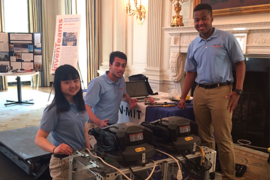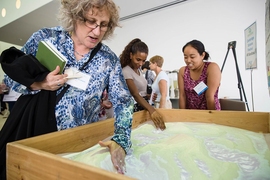Stephanie Couch is joining the Lemelson-MIT Program as executive director in July. She has dedicated her career to K-12 and higher education policy issues in school finance and education technology in California. Her passion is advancing STEM learning opportunities for all students across the nation.
Prior to joining the Lemelson-MIT Program, Couch was the interim associate vice president of research and professional development at California State University, East Bay; served as Bayer Executive Director of the Institute for STEM Education; and was the director for Gateways East Bay STEM Network at California State University, East Bay.
Couch was named Biotechnology Educator of the Year by the California Life Sciences Association in 2015 for her commitment to identifying strategic areas for joint action, addressing STEM education challenges, and increasing the understanding of best practices for attracting and preparing STEM teachers in urban schools.
Q: Why is it important to inspire kids to be inventors?
A: The act of inventing helps young people learn new ways of thinking and problem solving that will benefit them throughout their entire lives. During the pursuit of solutions to problems they care about, their creativity is unleashed. It is empowering, meaningful, and a catalyst for personal growth. As students put invention projects together — creating shoe soles, electronic textiles, paper speakers — like they do in the Lemelson-MIT Program’s Junior Varsity InvenTeams activities, they are using materials in new ways and constructing meaning in their own world. At the same time, they are discovering their capability. Creating something new, on your own, and making it work, can have an enormous impact on a kid’s confidence.
Q: What features do effective K-12 invention or STEM programs have in common?
A: When young people pursue questions or develop solutions to issues they care about, we give them a reason for acquiring new knowledge in many disciplines including, but not limited to STEM. The connection to their daily lives makes a difference. While I have great appreciation for STEM and its application to inventing, many young people decide at early ages that STEM is not for them. Inventing is a way to plug them in to the value of STEM skills.
The Lemelson-MIT Program does this by engaging young people in technological problem-solving through its InvenTeams and Junior Varsity (JV) InvenTeams programs. JV InvenTeams provides students in grades 7-10 an opportunity to hone their skills and enrich their STEM education through invention-based design activities. The program also gives them connections to inventor role models, another important example of how young people can aspire to be successful in STEM fields and make a meaningful impact in the world through technological invention.
Q: What’s your favorite invention and why?
A: The technology behind the World Wide Web is my favorite invention. It has enabled the world to be my library — everybody’s library — and provided us with unlimited technological resources. A close second is my iPod, which is the best personal fitness trainer I’ve ever had.









